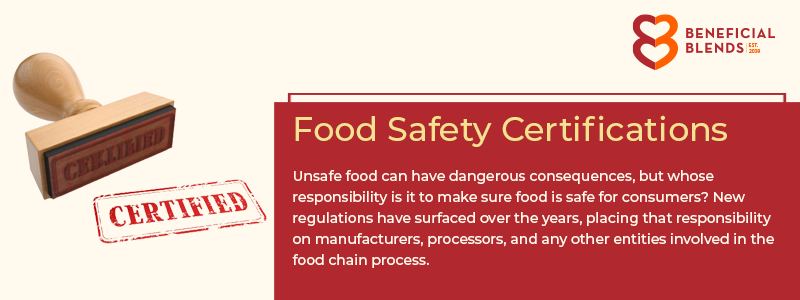
Food Safety Certifications
Unsafe food can have dangerous consequences, but whose responsibility is it to make sure food is safe for consumers? New regulations have surfaced over the years, placing that responsibility on manufacturers, processors, and any other entities involved in the food chain process. Originally reacting to issues with food safety, regulators switched to a preventative approach, by establishing preventative controls and guidelines.
Many different regulatory bodies implement food safety and quality regulations and standards across the globe. Some are recognized nationally while others are acknowledged on an international level.
The following certifications are the most highly recognized and accepted food safety and quality certifications a manufacturer, processor or business can receive.
GMP (Good Manufacturing Practice)
One standard that many look for in the food industry is GMPs. Businesses, manufacturers, and processors in the food industry have a moral obligation to produce food that is safe for consumers. The certification was created by the FDA to ensure optimal results for manufacturers and processors while eliminating risks, contamination, errors, or mix-ups that can be dangerous for consumers. These regulations include:
- Cleanliness
- Sanitation and Hygiene
- Equipment
- Document and Record-Keeping
- Pest Control
- Building and Facilities
According to the FDA, GMPs are “flexible to allow each manufacturer to decide individually how to best implement the necessary controls by using scientifically sound design, processing methods, and testing procedures. The flexibility in these regulations allows companies to use modern technologies and innovative approaches to achieve higher quality through continual improvement.”
While GMPs were introduced to ensure manufacturers are making safe and effective products. CGMPs were established to ensure that manufacturers are making continuous improvements to their processes. The ‘C’ stands for current and requires that companies use technologies and systems that are up to date.
HACCP (Hazard Analysis and Critical Control Points)
HACCP is a systematic approach to the identification, evaluation, and control of biological, chemical, or physical hazards. This certification is internationally recognized as a standard for food safety. There are seven HACCP principles:
- Conduct a Hazard Analysis
- Determine Critical Control Points
- Establish Critical Limits
- Establish Monitoring Procedures
- Establish Corrective Actions
- Establish Verification Procedures
- Establish Documenting and Record-Keeping Procedures
GMP can be the first step to HACCP but is not a replacement for it. Having this certification will help assure customers, clients, and partners that products are safe and effective.
SQF (Safe Quality Food)
The SQF certification is an assurance, assessment, and audit program recognized by all facets of the food industry to establish food quality and food safety standards. There are 3 levels to this certification with level 3 being the safest as far as safety standards go.
- SQF Level 1, also known as ‘Food Safety Fundamentals’ is an introductory level to food safety. This level covers GMPs and GAPs (Good Agricultural Practices).
- SQF Level 2 is recognized as the ‘Certified HAACP-Based Food Safety Plan’ and encompasses everything in Level 1, as well as HACCP practices.
- SQF Level 3 included everything from Levels 1 and 2 but takes additional action to prevent poor quality or contamination. This level is also called a ‘Comprehensive Food Safety and Quality Management System’.
SQF is acknowledged by the GFSI (Global Food Safety Initiative) and guarantees a higher degree of trust and acceptance in the marketplace.
